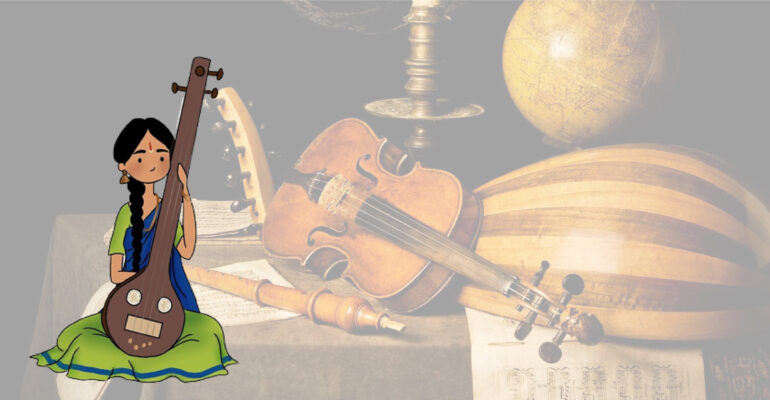Scale and mode in the music of the early Tamils of south India
August 25, 2022 2023-09-10 17:43Scale and mode in the music of the early Tamils of south India
Scale and mode in the music of the early Tamils of south India
The blog describes the scale, mode, and tonal system of South India and the Tamils, along with the raga and Tala names. It also details the music lineage of Silappadhikaram with Tamil music.
Tamils trace their legacy and origin to the Dravida culture of South India. At once, they had more than one third of South India under their reigns. Tamil is spoken by more than 87 million people across the world. Tamil speaking population is spread across various countries, with around 5.9% of total Total population in India (mostly from the southern most state of Tamil Nadu). More than 18% of Tamil speaking population is spread across Sri Lanka, and 4.5% across Singapore. Malaysia and Maurtius also house a significant portion of Tamil speakers.
Tamil language is one of the classical languages in the world that has survived thousands of years of invasions. Tamil language is known for its rich heritage, culture, tradition, musical scale, dance forms, and so on.
The blog describes the scale and mode of music of early Tamils of South India, and their contribution to the scale building concept of the world music.
Origin of Tamil Music
The musical tradition of Tamils is well established and is one of the ancient in the world. The development of their musical system is extensive, and extremely detailed. The Tamil system has a rich explanation beyond the development of the modes and Indian music scale. The Music Theory Spectrum, the official print journal of the Society for Music Theory reveals the extensiveness of the concept of scale-building in world music. It has laid down profuse interpretations on the same. The journal throws light on the mode of music and tonal system of South India, especially on those of the early Tamils. The journal exposes the tuning, rotation, pentatonic derivatives, and their generation.
There are basically five mode of music plotted upon the various phases of human love, water sources, creatures, beautiful flowers, times of the day, seasons of the year, and the five major landscapes namely kurunji, mullai (முல்லை), marudham (மருதம்), neidhal (நெய்தல்) and paalai (பாலை). The following section describes in detail, mode and the tonal system of South India, Indian scale, and 16 rags names in Tamil.
The Tamil modal system
The Tamil musical system is developed and owes its legacy to the parts of Tamil Nadu. A good music system has stability in its acoustics, definite intervals with differing distribution, uniform partitioning, uniform intervals, is void of modality, and has a good rotation pattern. The Tamil modal system complies with the four conditions, that form the standard for a viable hierarchical tonal system of South India.
The four conditions are,
- Well-defined subset interval classes in contrast with the cardinality of the set.
- Norm or deviant relationships that are caused by occurrence distribution.
- Stable acoustical intervals with high frequency. This aspect is very helpful in modulation, tuning, and tonality.
- The Indian scale and the modal system lets choosing between numerous keynotes and the functional relations can be realigned.
In addition, a good music system like the music system of early Tamils has only one tritone, two tetrachords, perceptible step sizes that are consecutive integers, and unmistakable sizes of fifths that are also consecutive integers, maximum consonant fifths, 1st order or 2nd order maximal evenness.
16 rags names in Tamil
Indian music scale possesses an innumerable number of ragas such that their precise count is unknown.
The classical Hindustani music is extensive and has more than 4 lakh ragas?
More than four lakh ragas are present in classical Hindustani music, out of which the concept of 16 swarasthanams acts as an eye opener. The 16 rags names in Tamil are listed below.
Swargasthanam
- Shadjam (ஷட்ஜம்)
- Sudha Rishabham (சுத ரிஷபம்)
- Chatushruti Rishabham (சதுஸ்ருதி ரிஷபம்)
- Shatshruti Rishabham (ஷத்ஸ்ருதி ரிஷபம்)
- Sudha Gandharam (சுத காந்தாரம்)
- Sadharana Gandharam (சாதாரண காந்தாரம்)
- Antara Gandharam (அந்தர காந்தாரம்)
- Sudha Madhyamam (சுத மத்தியமம்)
- Prati Madhyamam (பிரதி மத்தியமம்)
- Panchamam (பஞ்சமம்)
- Sudha Daivatam (சுத தைவதம்)
- Chatushruti Daivatam (சதுஸ்ருதி தைவதம்)
- Shatshruti Daivatam (ஷத்ஸ்ருதி தைவதம்)
- Sudha Nishadam (சுத நிஷதம்)
- Kaishiki Nishadam (கைசிகி நிஷதம்)
- Kakali Nishadam (கைகளை நிஷதம்)
These 16 rags names in Tamil are the principal features in the Indian music scale. The octave sa re ga ma pa dha ni sa has distinctive nesting of 22, 12, 7, and 5 divisions. We find interpretations of the music theory spectrum in the Tamil epic Silappadikaram.
Talas – Rhythmic organization of South India
Similar to how the classification of Ragas is better done in South Indian music scale, so does the Talas. There are thirty five key Talas, and each Tala is made of short, medium and long units. The medium Tala has twice the duration of short Tala, and the longer one has either three, four, five or seven times the duration of shot Tala.
The seven basic Tala patterns are listed below –
- Dhruva Tala – Long, Medium, Long, Long
- Mathya Tala – Long, Medium, Long
- Rupaka Tala – Medium, Long
- Jhampa Tala – Long, Short, Medium
- Triputa Tala – Long, Medium, Medium
- Ata Tala – Long, Long, Medium, Medium
- Eka Tala – Only a single Long
Mode of music in Silappathikaram
Silappathikaram, the great Tamil epic revolving around the life of Kovalan and Kannaki has many lyrical episodes. The epic is divided into three books with 25 cantos and 5 song cycles. It is said that Carnatic musical tradition of South-India evolved from the musical system described in Silappathikaram and its two principal commentaries. We must recall that a song sung by Madhavi turned the story into a series of tragic events.
Learn Tamil Online
Learning Tamil is easier than ever before. Powerkid Tamil Academy has been in the field of Tamil language education for more than 5 year. For our online class in Tamil, we have customised syllabus, and curriculum intended to help the immigrants help carry forward the Tamil legacy and culture to children. We present an opportunity for everyone to learn Tamil online from the comfort of your home, anywhere, anytime. All our classes are handled by Tamil speaking native teachers. The online Tamil class is one-on-one, live, and fully customisable to ensure a great learning experience.
Sign up to our online Tamil class and learn Tamil online at www.powerkidtamil.com or contact us at +1 (512) 575-3590 or +91 74033 33135.










